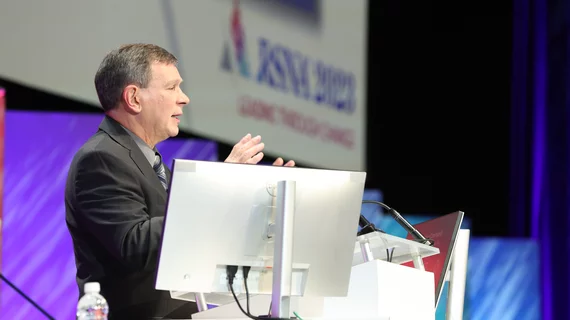With an uncertain labor market and the rise of AI, RSNA president says radiology faces a '10x force'
The theme of this year’s annual Radiological Society of North America meeting is “Leading Through Change” and the opening remarks from RSNA president Matthew Mauro, MD, emphasized that, although the shifting nature of radiology work is scary, it’s also a “necessity” to drive improvement.
With the rise of new point-of-care imaging techniques, artificial intelligence, and an “unstable labor market,” radiology is facing a “10x force” akin to a hurricane as it manages a series of existential crises. But, Mauro said embracing change and good business sense will help imaging practices to weather the storm—and come out stronger on the other side.
“For many of us, medicine satisfies a calling—a desire to help others. But in today’s world, medicine is also a business. As physicians, we are in the business of helping people and our business is impacted by the same rules and forces that effect other businesses,” he told attendees Sunday, referring to patients as “customers” and calling for practices to be mindful of the need to provide excellent service.
Mauro said staying competitive by doing quality work is vital as interventional radiology moves away from referral-based operations. The “power of future competitors” has reshaped what it means to work in imaging, as more challengers emerge, taking image-guided interventions away from the specialty. But, he noted that embracing the changing landscape has helped interventional radiology to elevate itself to specialty status and better manage patient expectations—and as education catches up with the evolution of technology, practices have weathered the storm.
However, to remain on the cutting edge, Mauro reiterated the need to improve the happiness of radiologists and imaging technologists, who often struggle with burnout.
“Chairs, chiefs and group presidents are often the last to know when a high degree of frustration exists in a practice,” he said. “We need to do a better job of listening to our people on the front line.”
The rise of AI
As always, AI is a central focus of the conference, with new research being revealed, vendors showing off the latest tech, and RSNA itself sponsoring AI-related competitions. So, Mauro seemed to be asking the question on everyone’s mind: “As technology gains power, what does the future hold for radiologists?”
Calling AI another “10x force,” he believes the rise of machine learning presents an opportunity to improve the lives of providers “freeing the radiologists to devote their time to the more enriching aspects of our work.”
Mauro suggested radiologists stop fearing AI and instead learn to adapt and embrace it. Conversations should be focused on how to properly and ethically implement these models to ensure they serve humanity. To do that, radiology practices need to stop resisting the inevitable and embrace the new frontier.
“If we constantly embrace change … radiology will most certainly enjoy a robust, exciting, and bright future,” he concluded.

